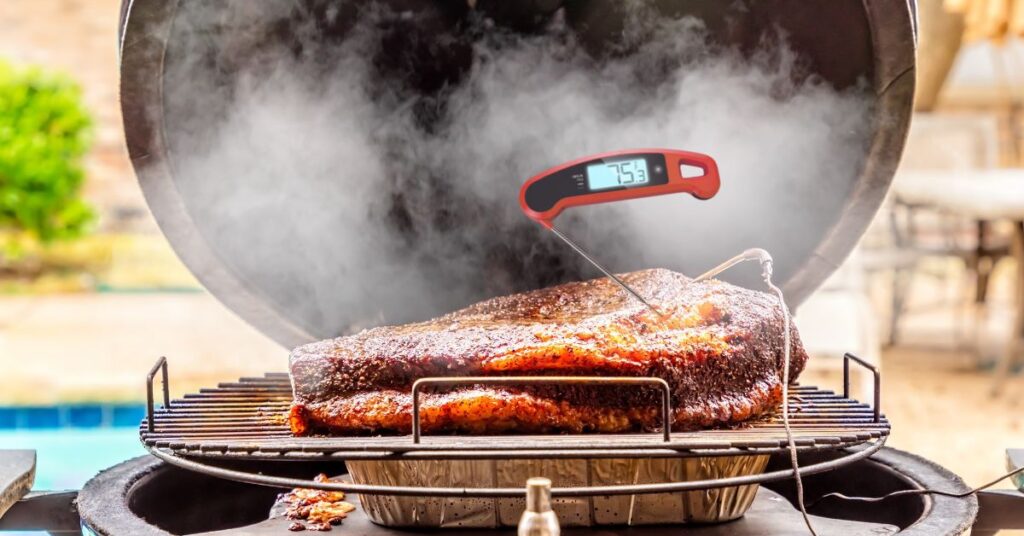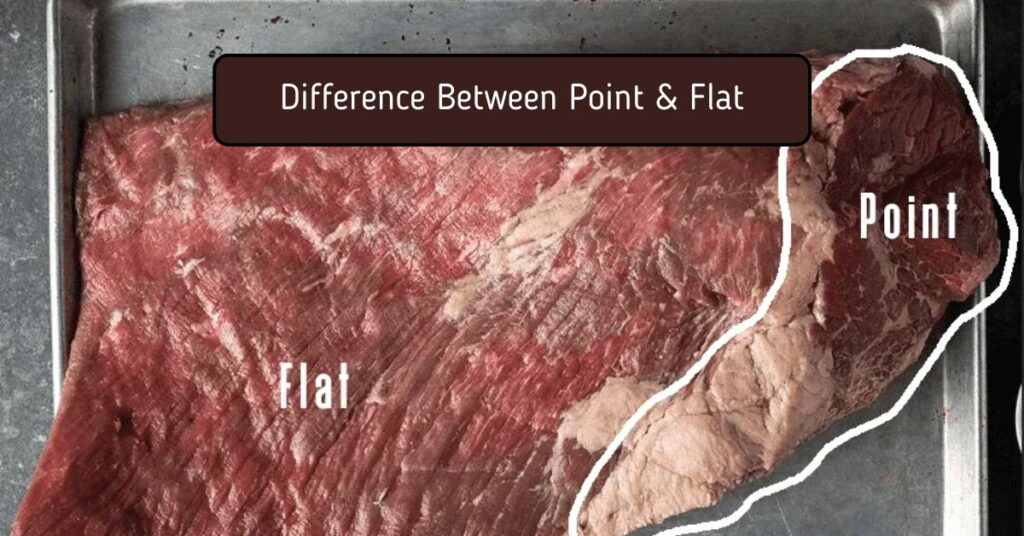Quality brisket takes time to cook and is not an easy meal to prepare. The art of cooking requires patience and skill. It is possible to improve both of them through practice. To prepare brisket properly, it is important to know its internal temperature. Removed too quickly it will remain undercooked and removed too late and it will overcook.

In this article, we will explain the tips on where to probe brisket. It’s challenging to cook brisket because of the two types of muscle: flat and point. the two types of muscle: flat and point. Both of them have different cooking temperatures. So controlling the temperature was essential, but it was not that hard. Now let’s get started.
Probing The Brisket: Where To Start
The ideal place to probe the brisket is the flat of the brisket rather than the point. This is because the flat has less fat than the point and will take a little longer. It is also recommended that you insert the probe horizontally into the flat. Rather than vertically so that the accuracy of temperature is ensured.
Probing the point only will not give an accurate reading. Since the point is cooked before the flat. So only relying on the point temperature can cause the flat to remain undercooked.
Also, make sure you don’t insert the probe at different places in the flat. To prevent moisture loss, do not probe too many holes in the meat. Always aim for the same spot as previously to prevent drying out.
It is also due to the fact that the point of the thermometer is not uniform that the flat is chosen for probing instead. As a result, the flat is more reliable for temperature readings. Flat also contains more meat and fewer fat pockets relative to point. Inserting the probe into the thicker and denser part of the flat will give a more reliable result.
It is also common to ask how often the brisket should be probed during cooking. You don’t have to insert the probe for the first five to hours when the temperature will be about 150 to 140F.
After that keep probing the brisket every 30 min. Until the desired temperature is reached. In this way, you can have a uniform internal and you don’t have to probe every minute.
Difference Between: Point and Flat

Brisket is mainly divided into two parts based on the meat and fat ratio:
- Point is the round side of the brisket that has a lot of fat and connective tissue which helps it to cook quicker.
- Flat is the brisket’s lean side, which is why it lays flat. This site takes relatively more temperature to cook.
Since the point has more flavor to this due to the concentration of fat and less meat. As a result, it is ideal for shredding into sandwiches and found at burger parties.
Separating the Flat and point
Some people also prepare both of them separately. To do so, cut through the deckle which is the thick fatty large seam part of the brisket. But this some practice you will be able to prepare the whole brisket in one go.
At what temperature Brisket is done?
Now let’s get to the good part: what is the right temperature for brisket to prepare? The simple answer to this question is that there is no fixed temperature. But rather than a temperature zone that is between 195 to 203 Fahrenheit. Which needed to be attained to make sure the brisket was prepared correctly.
So you have to rely on the temperature and the feel of the brisket. Brisket is the cutout meat of the lower chest of beef or veal. Some healthy cows have a more developed pectoral region, which makes the meat a little tougher. This means more time is needed to prepare that meat.
Once the temperature reaches the recommended zone cook the brisket for about 30 min. You need to be patient because the cooking process of briskets takes hours rather than minutes. You also have had to wait through the stall which starts at about 150 to 155 F.
What is the stall?
The stall is the stage at which the temperature of the briskets stops rising for a while. But after some time it will rise again eventually. Usually, this occurs when the temperature reaches 150 to 155 Fahrenheit. At this temperature range, the moisture of the meats starts to evaporate. Which leads to a drop in temperature. Or, you can say that the meats begin to sweat.
It can take a few hours before the temperature starts to rise again. However, there is a technique that is used by restaurants to speed the process known as Texas Crutch.
Texas Crutch Technique:
Texas Crutch was popular during the BBQ competition. ng the BBQ competition. But now is even used in many restaurant settings. Yes, there is competition for BBQs all around the world, especially in America.
In this method, the meat is wrapped in aluminum foil, and forgetting to close the lid of the grill. Once wrapped place it back again and keep measuring the temperature.
Once 203 F is reached it will be cooked you can confirm by probing the thermometer into the brisket. If the thermometer is inserted without any resister kind of like putting a knife in butter then it is ready.
It not only speeds up the cooking process but also stops the moisture from escaping. This method has its setback which is that the edges of the basket will not be crisp. But this is nothing that can be fixed with little effort. If you unwrap the brisket and grill it for another 30 minutes, you will get crispy bark. So next time you can prepare brisket faster for a party.
Type Of Probe To Use
A skilled pitmaster can tell the state of the meat by looking at it. But an untrained person needs the proper tools to prepare one. So which thermometer probe is ideal for the brisket? Different types of probes are available on the market there are a few types that you can consider.
Instead Thermometer
Instead, the thermometer is the must-have tool for preparing brisket and other meat. This thermometer can read the temperature in real time. This saves time and you can check multiple areas on the brisket. Lavatools Javelin PRO is one of the best thermometers on the market. It is also economical in price and is ideal for brisket.
Multi-Thermometer
When it comes to measuring brisket temperature, a multi-thermometer is overkill. These thermometers have more than one probe. This makes them an ideal measure of the different areas of the brisket at the same time. Along with the internal temperature of the grill.
ThermoPro TP20 is a dual probe for measuring temperature. You can use one probe to measure the temperature of the point and the other for the flat.
Wireless/Smart Thermometer
Smart thermometers are also the wireless connectivity most of the time. This uses Bluetooth technology to connect with your smartphone and send real-time data. The water-resistant and heat-resistant property of these probes is ideal for grilling. It contains dual sensors one for meat and the other for surroundings.
MEATER Plus is a smart probe that can be used to prepare brisket. You don’t have to open-lit once placed in meat the ceramic handle allows it to be heat resistant. Select the type of food you are preparing and place the probe. Once the cooking temperature is reached you will get notified.
Check out some of more best thermometers available on the market!
FAQs
Where should you probe brisket?
The best place to probe the brisket is the densest part of the flat. Because this part has more meat and less fat. Due to this reason, it takes a little longer than the point of the brisket. Insert the probe horizontally along the grain.
What is the Texas Crutch?
Texas Crutch is a technique that is used by experienced Pitmasters. This speeds up the stall stage of cooking. During the stall, the moisture of the meat starts to evaporate and the temperature doesn’t rise for a while.
Once the brisket reaches 150 degrees Fahrenheit stall stage starts. Wrap the brisket in aluminum foil or butcher paper. This will write the temperature more quickly than without the wrap.
Is brisket beef or pork?
Brisket is the beef that is cut out of the lower chest or pectoral muscles. Because they are exercised frequently. They contain connective tissues, which make them tough. Which makes it ideal for slow cooking at low temperatures.
The Bottom Line
In this article, we have covered all the information you need to prepare a delicious brisket. Including where to probe the brisket and what temperature to cook it at. The flat is the leaner side of the brisket. That contains mostly meat and less fat so make sure you insert the probe vertically.
Using tools like multi-probe and smart thermometers does make the job a little easier. But practice is most important in determining when the brisket is cooked. After some experience, you can tell if the brisket is one based on its appearance alone.